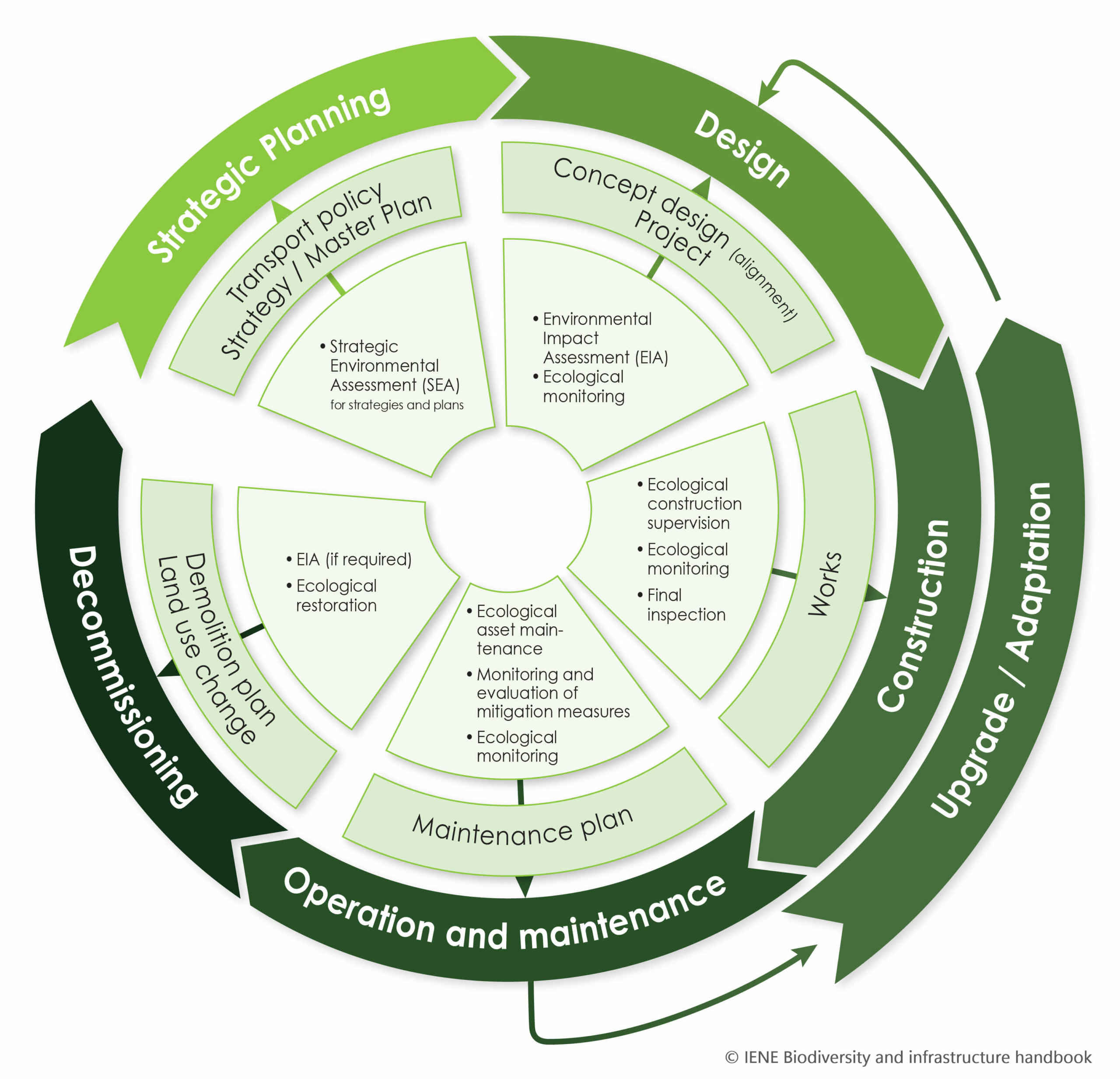Overview
Integrating biodiversity conservation considerations in all phases of the infrastructure development life cycle is key to achieve sustainable transport systems. The project life cycle phases are strategic planning, design, construction, operation and maintenance, upgrading or adaptation, and finally decommissioning (where applicable).
To ensure that nature and the benefits it provides to people are mainstreamed into the transport infrastructure life cycle, countries and regions should align their transport policies and strategies with international environmental agreements, and all relevant sustainability standards and regulations. Potential benefits to ecosystems and the services they provide to people could also be preserved or restored if infrastructure is appropriately planned, designed and maintained. Upgrading and adaptation of infrastructure under operation offer great opportunities for ecological restoration.
Main messages
- Strategic planning: In this phase, the vision and goals for transport corridors are defined. These should build from relevant transport and biodiversity policies by identifying the needs for transport infrastructure and biodiversity conservation across Europe´s regions and countries, considering also ecological connectivity. The main tool used here is Strategic Environmental Assessment (SEA). Avoiding the need for new infrastructure development is a key option to be considered in this phase.
- Design: The optimal route or site is selected, testing different scenarios and their potential impacts on biodiversity. This includes obtaining permits and selecting contractors. Key to this phase is avoiding and reducing negative impacts as well as establishing a biodiversity baseline to help design mitigation measures and allow subsequent monitoring. The main tool used here is Environmental Impact Assessment (EIA) and well-established public procurements that fully integrate biodiversity among its goals.
- Construction: biodiversity mitigation actions are implemented following the decisions made previously, integrated into public procurements, and monitored during the construction process to apply corrective mitigation measures if needed.
- Operation: The effects of infrastructure operation and management on priority species and habitats should be assessed. Key phase to apply best practice for maintenance and ensure negative impacts on biodiversity are adequately managed. The approved monitoring plan defined within the EIA is the tool used to make this assessment, and corrective measures are put in place when needed.
- Decommissioning: If decommissioning is undertaken, biodiversity mitigation measures during demolition, restoration and monitoring plans are important considerations. Here, there are opportunities to improve the condition of ecosystems and ecological networks through restoration. However, many infrastructure developments do not have an end date and are maintained or upgraded over time.
- Upgrade and adaptation: These measures often do not follow standard design and construction processes, but they require special attention to avoid further impacts on biodiversity (upgrade) and reduce existing ones (adaptation). Nature-based Solutions (NbS) are a key tool here to avoid negative effects from climate change and benefit biodiversity.
Actions to take
- Infrastructure planning is a multilateral process and should include meaningful consultation with local communities and other relevant stakeholders, especially during strategic planning and design where cumulative impacts come into play and are often poorly assessed. The consideration of specific issues related to biodiversity implies broadening the approaches to cumulative effects at the territorial level.
- When assessing and addressing the impacts of transport on nature, the mitigation hierarchy approach, ‘Avoidance-Reduction-Compensation’, should be applied prioritizing to avoid any negative effects (see Chapter 3 – The mitigation hierarchy). This applies to direct, indirect, and cumulative effects.
- Impact assessment should follow and comply with the European Union directives for Strategic Environmental Assessment (SEA Directive 2001/42/EC) and Environmental Impact Assessment (EIA Directive 2014/52/EC).
- Whether any Natura 2000 sites are potentially affected by the analysed infrastructure project, an Appropriate Assessment must follow the Habitat Directive’s requirements (1992/42/EEC).
- Adaptive infrastructure maintenance plans must be applied as they allow to identify opportunities to benefit biodiversity, adapt to climate change and increase infrastructure resilience.
- Defragmentation of existing infrastructure must be considered in all upgrading projects as well as in maintenance practice. Providing new safe wildlife passages contributes to reduce animal-vehicle collision risks, allow the movements of animals and restore ecological connectivity.
- Impacts from climate change on infrastructure and biodiversity need to be appropriately integrated into current transport planning. This includes the impacts of actions required to adapt infrastructure to climate hazards (e.g. floods or erosion), and the opportunities to find solutions that provide synergic benefits.
- The adoption of new technologies should be considered to allow better integration of data along the complete infrastructure life cycle and help make decisions more efficiently.
- Cumulative effects analyses should be better developed and integrated into environmental assessment procedures.
- The importance of areas where nature must be preserved from any infrastructure development needs to be recognized and these areas identified in each region or country.
